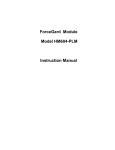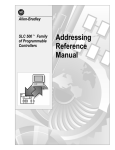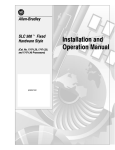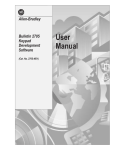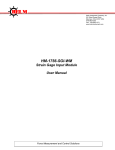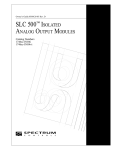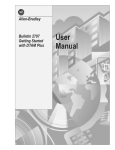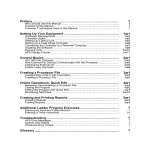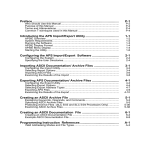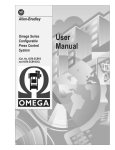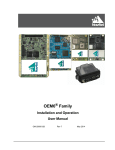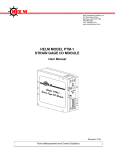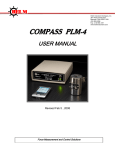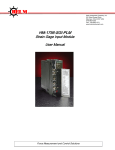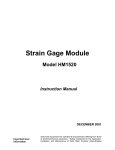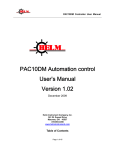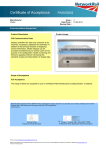Download hm571-resolver-input.. - Helm Instrument Company Inc.
Transcript
Important User Information Solid state equipment has operational characteristics differing from those of electromechanical equipment. “Safety Guidelines for the Application, Installation and Maintenance of Solid State Controls” (Allen-Bradley Publication SGI-1.1) describes some important differences between solid state equipment and hard-wired electromechanical devices. Because of this difference, and also because of the wide variety of uses for solid state equipment, all persons responsible for applying this equipment must satisfy themselves that each intended application of this equipment is acceptable. In no event will the Allen-Bradley Company or Helm Instrument Company be responsible or liable for indirect or consequential damages resulting from the use or application of this equipment. The examples and diagrams in this manual are included solely for illustrative purposes. Because of the many variables and requirements associated with any particular installation, the Allen-Bradley Company or Helm Instrument Company cannot assume responsibility or liability for actual use based on the examples and diagrams. No patent liability is assumed by Allen-Bradley Company or Helm Instrument Company with respect to use of information, circuits, equipment, or software described in this manual. Reproduction of the contents of this manual, in whole or in part, without written permission of the Allen-Bradley Company and Helm Instrument Company is prohibited. Throughout this manual we use notes to make you aware of safety considerations. ATTENTION: Identifies information about practices or circumstances that can lead to property damage. Identifies information that is especially important for successful application and understanding of the product. Attentions help you: • identify a hazard • avoid the hazard • recognize the consequences PLC, PLC2, PLC3, and PLC5 are registered trademarks of the Allen-Bradley Company, Inc. SLC, SLC500, PanelView, RediPANEL, Dataliner are trademarks of Allen-Bradley Company, Inc. IBM is a registered trademark of International Business Machines, Incorporated. ForceGard is a registered trademark of the Helm Instrument Company, Inc. Revised 7-97 Table of Contents Resolver Input Module User Manual Preface ............................................................................................. P-1 Who Should Use this Manual........................................................... P-1 Purpose of this Manual .................................................................... P-1 Contents of this Manual.............................................................. P-2 Related Documentation .............................................................. P-3 Terms and Abbreviations ................................................................. P-4 Common Techniques Used in this Manual ....................................... P-6 Product Support.......................................................................... P-6 Your Questions or Comments on this Manual ............................. P-6 Overview Chapter 1 ..........................................................................................1-1 Module Components........................................................................ 1-1 Resolver Operation .......................................................................... 1-1 Features........................................................................................... 1-1 Hardware Overview ......................................................................... 1-2 Hardware Features .......................................................................... 1-3 Getting Started Chapter 2..........................................................................................2-1 Getting Started ................................................................................ 2-1 Required Tools and Equipment ....................................................... 2-1 System Operation ............................................................................ 2-2 Resolver Wiring................................................................................ 2-2 Channel Configuration, Data and Status Chapter 3 ..........................................................................................3-1 Channel Configuration, Data and Status .......................................... 3-1 Module Addressing .......................................................................... 3-1 Resolver Module ID Code 3535..................................................... 3-1 Data Table Memory Map ................................................................. 3-1 Output Image ................................................................................ 3-1 Input Image ................................................................................... 3-2 Integer File .................................................................................... 3-3 Table of Contents Resolver Input Module User Manual Initial Setup Procedures Chapter 4 ........................................................................................ 4-1 Initial Setup Procedures ................................................................... 4-1 Step 1. Set Master/Slave Mode .................................................. 4-1 Step 2. Set Mode Bit to Setup .................................................... 4-2 Step 3. Calibrate Resolver Module for Slave Operation.............. 4-3 Step 4. Set Forward/Reverse Operation Mode........................... 4-4 Step 5. Adjust Resolver Offset.................................................... 4-4 Step 6. Set Mode Bit to Run ....................................................... 4-5 Additional Application Notes........................................................ 4-4 Strokes per Minute (SPM) Calculation ........................................ 4-6 Download Bit............................................................................... 4-7 Chapter 5 ........................................................................................ 5-1 Wiring Diagrams Resolver Wiring Diagram ................................................................. 5-1 Preface Preface Read this preface to familiarize yourself with the rest of this manual. This preface covers the following topics: • • • • • who should use this manual the purpose of this manual terms and abbreviations conventions used in this manual Allen-Bradley support Use this manual if you are responsible for the design, installation, programming, or Who maintenance of an automation control system that uses Allen-Bradley small logic Should Use controllers. this Manual You should have a basic understanding of SLC 500 products. You should understand electronic process control and be able to interpret the ladder logic instructions required to generate the electronic signals that control your application. If you do not, contact your local Allen-Bradley representative for the proper training before using this product. Purpose of This manual is a learning and reference guide for the Helm Resolver Input Module. It this Manual contains the information you need to install, wire, and use the module. P-1 Preface Contents of this Manual Chapter Title Content Preface Describes the purpose, background, and scope of this manual. Also specifies the audience for whom this manual is intended and defines key terms and abbreviations used throughout this book. 1 Overview Provides a hardware and system overview. Explains and illustrates the components of the system. 2 Installation and Wiring Provides installation information and wiring guidelines. 3 Channel Configuration, Data and Status Examines the channel configuration and the channel status word, and explains how the module uses configuration data and generates status during operation. 4 Ladder Programming Examples Gives an example of the ladder logic required to define the module for operation. Also includes representative examples for unique requirements such as strokes per minute calculation and resolver offset. 5 Wiring Diagrams A Specifications B Ladder Program Provides physical, electrical, environmental, and functional specifications for the module. P-2 Preface Related Documentation The following documents contain information that may be helpful to you as you use Allen-Bradley SLC products. To obtain a copy of any of the Allen-Bradley documents listed, contact your local Allen-Bradley office or distributor. For Read this Document Document Number An overview for the SLC 500 family of products SLC 500 System Overview 1747-2.30 A description on how to install and use your Modular SLC 500 programmable controller Installation & Operation Manual for Modular Hardware Style Programmable Controllers 1747NI002 A description on how to install and use your Fixed SLC 500 programmable controller Installation & Operation Manual for Fixed Hardware Style Programmable Controllers 1747-NI001 A procedural manual for technical personnel who use APS to develop control applications Allen-Bradley Advanced Programming Software (APS) User’s Manual 1747-NM002 A reference manual that contains status file date, instruction set, and troubleshooting information about APS Allen-Bradley Advanced Programming Software (APS) Reference Manual 1747-NR001 An introduction to APS for first-time users, containing basic concepts but focusing on simple tasks and exercises, and allowing the reader to begin programming in the shortest time possible Getting Started Guide for APS 1747-NM001 A procedural and reference manual for technical personnel who use an HHT to develop control applications Allen-Bradley Hand-Held Terminal User’s Manual 1747-NP002 An introduction to HHT for first-time users, containing basic concepts but focusing on simple tasks and exercises, and allowing the reader to begin programming in the shortest time possible Getting Started Guide for HHT 1747-NM009 A resource manual and user’s guide containing information about the analog modules used in your SLC 500 system SLC 500 Analog I/O Modules User’s Manual 1746-NM003 A complete listing of current Automation Group documentation, including ordering instructions. Also indicates whether the documents are available on CD-ROM or in multi-languages Automation Group Publication Index SD499 A glossary of industrial automation terms and abbreviations Allen-Bradley Industrial Automation Glossary ICCG-7.1 An article on wire sizes and types for grounding electrical equipment National Electrical Code Published by the National Fire Protection Association of Boston, MA. P-3 Preface Terms and The following terms and abbreviations are used throughout this manual. For definitions Abbrevia- of terms not listed here refer to Allen-Bradley’s Industrial Automation Glossary, Publication ICCG-7.1. tions Calibration - Procedure, performed by trained personnel, to set the RMS (mean square root) voltages of the resolver. Chassis - A hardware assembly that houses devices such as I/O modules, adapter modules, processor modules, and power supplies. Configuration Word - Contains the configuration information needed by the module to configure and operate. Information is written to the configuration word through the logic supplied in your ladder program. Data Word - A 16-bit integer that represents the value of the analog input channel. The channel data word is valid only when the channel is enabled. LSB - (Least Significant Bit) Refers to a data increment defined as the full scale range divided by the resolution. The bit that represents the smallest value within a string of bits. Master/Slave Operation - Selectable mode of module operation. Default is Master when module is wired to a Helm Model HR1101 resolver. Mode is Slave when module receives input by tapping off of an existing resolver. Slave mode requires a calibration procedure. Monitor Mode - Normal run state. Multiplexer - A switching system that allows several input signals to share a common A/D converter. Offset - A value represented in degrees to restore resolver to zero at the top of the stroke. Required when resolver has not been mechanically set to zero. Remote Configuration - A control system where the chassis can be located several thousand feet from the processor chassis. Chassis communication is via the 1747-SN Scanner and 1747-ASB Remote I/O Adapter. Resolution - The smallest detectable change in a measurement, typically expressed in engineering units (e.g. 0.15C) or as a number of bits. For example a 12-bit system has 4,096 possible output states. It can therefore measure 1 part in 4096. Resolver - Sometimes called encoder. Device attached on a machine to determine machine stroke position. Sine/cosine based resolver required for Helm Resolver Input Module. Sampling time - The time required by the A/D converter to sample an input channel. P-4 Preface Terms and Abbreviations (continued) Scale - Value used to describe the press/machine overall tonnage. Set for maximum value of one channel. For example, settings for a 150 ton press = 75. Setup Mode - Status condition of module. Normally enabled to perform calibration and setup procedures. Status Word - Contains status information about the channel’s current configuration and operational state. You can use this information in your ladder program to determine whether the channel data word is valid. Strokes per Minute (SPM) - Value calculated when a machine cycles through a complete rotation ( 0 to 360 degrees). . TSM - Acronym for Through-the-Stroke load monitoring. Resolver input is required for monitoring the load being developed during machine cycle. Update Time - The time required for the module to sample and convert the input signals of all enabled input channels and make the resulting data values available to the SLC processor. P-5 Preface Common Techniques Used in this Manual The following conventions are used throughout this manual: Product Support Contact your Helm representative or call Helm direct at 419/893-4356: • • • • • • Bulleted lists such as this one provide information, not procedural steps. Numbered lists provide sequential steps or hierarchical information. sales and order support product technical training warranty support support service agreements Your Questions or Comments on this Manual If you have any suggestions for how this manual could be made more useful to you, please send us your ideas. P-6 Appendix Electrical Specifications: Physical Specifications: A Backplane Current Consumption 49m@5VDC 57m@24VDC Backplane Power Consumption 2W Number of Channels 1 I/O Chassis Location Any I/O module slot except 0 Calibration Manual Calibration Isolation 500 VDC continuous between inputs and chassis ground, and between inputs and backplane LED Indicators 1 Power Indicator 1 Communications Indicator Module ID Code 3535 Recommended Cable Resolver Cable #27081 Terminal Strip 8-pin removable Environmental Specifications: Operating Temperature 0°C to 60°C (32°F to 140°F) Hazardous Environment Classification Class 1 Division 2 Hazardous Environment Input Specifications: Type of Input Resolver Display Resolution 0.1º Overall Module Accuracy /- 8+ 1 LSB arc mins. Module Update Time 200µsec Page A-1 Chapter 1 Overview You have just purchased the most advanced Programmable Limit Switch/Die Monitoring solution available. HELM INSTRUMENT COMPANY, INC. manufactures a complete line of monitoring control solutions for use on metal stamping, forging, compaction and assembly presses; cold forming, cold heating, injection molding and die cast machines. Resolvers, standard or custom transducers and load cells are available for in-die monitoring of transfer or progressive tooling. At HELM, quality is inherent not only in the design of our products but in the attitudes of our employees as well. We’re working together to give you the best. After all, that’s what our business is all about - providing innovative instrumentation to help make your manufacturing process more productive and your operation more effective. The Helm Resolver Input module provides intelligent absolute position feedback to the Allen-Bradley SLC family of programmable controllers. The module supplies A-B processors position and velocity data from ultra-reliable resolver based transducers. Each HM571-RES module occupies a single slot in the I/O rack. Position data is updated every 200 micro seconds. Up to 16 user programmable on/off states enable programmable limit switching to enhance control solutions. Features include: velocity data acquired at up to 2000 RPM, programmable position resolution up to 4096 counts per turn and a programmable resolver offset value. When used with the Helm ForceGard strain gage input module, the resolver module provides for real time signature analysis. Components The Helm Resolver module resides on the backplane of the Allen-Bradley 1746 SLC-5/03. The system is comprised of two parts; the input module and a sine/cosine based resolver such as the Helm Model HR-1101 resolver. The HR-1101 sine/co-sine Resolver is housed in a rugged enclosure designed especially for industrial applications. The resolver is a very accurate absolute position shaft encoder known for it’s extreme durability. Helm resolvers are passive devices which consist of brushless rotary transformers with one rotor and two stator windings. These windings are positioned at 90 degrees apart from one another thus providing a sine and cosine analog output signal corresponding to the shaft position. Page 1-1 Chapter 1 Hardware Overview The resolver module fits into any single-slot, except the processor slot(0). It is a Class 1 module (uses eight input words and eight output words). The Helm Resolver input module can accept input from one resolver. Multiple Helm HR-1101 resolvers can be wired in paralleled to one resolver input module. The module has no output channels. Module configuration requires manual and user programmable setup. The resolver module receives and stores digitally converted analog data into its image table for retrieval by modular SLC 500 processors. Page 1-2 Chapter A S U NI E D A M O C T N E MU RT S NI ML E H Hardware Features 1 TRANSMIT ANALOG S OC REF J4 POWER SIN R25 R24 R23 R22 J3 (COS) (REF) (SIN) (MASTER) REF J6 S1 (SLAVE) J1 TRANSMIT 51 R (FORWARD) S2 (REVERSE) HELM INSTRUMENT CO., INC. MAUMEE, OHIO USA Power LED Indicates 5 volts is supplied. Transmit LED Indicates module is communicating to processor. Door Label Resolver wiring diagram Transmit Connector Connector for communication with Helm ForceGard module via Receive IN jack. 8-Pin Connector For resolver input wiring. Dip Switches S1- Adjustment for Master/Slave operation. S2- Adjustment for Forward/Reverse resolver rotation. Potentiometers Three of the four pots are used for calibrating the resolver, a sine adjust, a cosine adjust and a reference adjust for slave operation. Voltage Test Points Used with voltage meter when adjusting sine/ cosine potentiometers. Page 1-3 Chapter Getting Started 2 This chapter can help you to get started using the Helm Resolver input module. The procedures included here assume that you have a basic understanding of SLC 500 products. You should understand electronic process control and be able to interpret the ladder logic instructions required to generate the electronic signals that control your application. Because it is a start-up guide, this chapter does not contain detailed explanations about the procedures listed. It does, however, reference other chapters in this book where you can get more information about applying the procedures described in each step. It also references other SLC documentation that may be helpful if you are unfamiliar with programming techniques or system installation requirements. If you have any questions or are unfamiliar with the terms used or concepts presented in the procedural steps, always read the referenced chapters and other recommended documentation before trying to apply the information. This chapter will: • • • tell you what equipment you need explain how to install and wire the module show you how to set look windows for resolver input Have the following tools and equipment ready: Required Tools and • small blade screwdriver Equipment • voltage meter • potentiometer trimmer (tweeker) • appropriate resolver cable • programming equipment (All programming examples shown in this manual demonstrate the use of Allen-Bradley’s Advanced Programming Software [APS] for personal computers.) Page 2-1 Chapter System Operation Resolver Wiring 2 The Resolver module communicates to the SLC processor through the parallel backplane interface and receives +5Vdc and +24Vdc power from the SLC power supply through the backplane. No external power supply is required. You may install as many Resolver modules in your system as the power supply can support. The module contains an 8-pin orange connector for wiring resolver. The pin-out is shown below. POWER TRANSMIT AN AL OG TRANSM IT HELM INSTRUM ENT CO., INC. M AUM EE, OHIO USA To ensure proper operation and high immunity to electrical noise, always use Helm resolver cable. (Part Number 6117). To limit noise, keep resolver cable as far away as possible from power and load lines. Page 2-2 Chapter 3 This chapter explains how the Resolver Input module and the SLC processor Channel through the module's input and output image. It lists the preliminary setup Configuration, communicate and operation required before the module can function in a 1746 I/O system. Data and Status Module Addressing ForceGard Module ID Code 3535 Output Image The module identification code is a unique number encoded for each 1746 I/O module. This code defines for the processor the type of specialty I/O module residing in a specific slot in the chassis. With APS software, manually enter the module ID code. No special I/O configuration (SPIO CONFIG) information is required. The module ID code automatically assigns the correct number of input and output words. The following memory map shows how the output and input image tables are defined. The 8 word output image (output from the CPU to the module) contains information that you configure for your application. Example - If you want to set the value of the SLC data pointer on the module located in slot 4 in the SLC chassis, your address would be O:4.2. (O = file type : =element delimiter 4 =slot . =word delimiter 2 =word) Bit Bit Bit Integer SETUP MODE BIT RUN MODE BIT DOWNLOAD BIT DEGREE OFFSET O:e/0 O:e/1 O:e/2 O:e.1 Setup Mode Bit (O:e/0) When set on (1) module is in calibrate mode. Run Mode Bit (O:e/1) When set on (1) module is in run mode. Download Bit (O:e/2) Enabled during system power-up to download settings to processor. Degree Offset (O:e.1) Number of degrees required to zero balance the resolver. Offset is required when the resolver is not mechanically set. SPM Timing Value (O:e.3) Used for internal calculation of Strokes Per Minute. Page 3-1 Chapter 3 The 8-word module input image (input from the module to the CPU) represents data Data Table words and status words. Input Image Input words (data words) hold the input data that represents the values of the resolver inputs. Input words (status bits) contain the various status conditions and reflect the configuration settings you have entered into the output configuration words. (I =file type : =element delimiter 2 =slot Integer DEGREE VALUE Integer SPM Timing Value . =word delimiter 0 =word / 2 =bit) I:e.1 I:e.3 SPM - Strokes per Minute (I:e.3) Integer word, calculation register based on machine cycle, resolver rotation from 0-360 degrees. Page 3-2 Chapter 3 Data Table Using APS software, reserve an entire Integer file (128 words). Integer File For illustration purposes in this manual, we have reserved Integer file N12:0 - N12:128. Data Description Address Bit RESOLVER RUN/SETUP MAINTAINED BUTTON FROM OPERATOR INTERFACE SEND OFFSET MOMENTARY BUTTON FROM OPERATOR INTERFACE CLEAR OFFSET MOMENTARY BUTTON FROM OPERATOR INTERFACE PRESS IN MOTION INDICATOR OFFSET VALUE (0-3599) REGISTER USED FOR COMPARING TWO ANGLES SPM TIMING VALUE PASSWORD FOR CLEARING OR SENDING OFFSET (VALUE IS ENTERED IN LADDER LOGIC TO COMPARE TO ENTERED VALUE) TEMPORARY CALCULATION REGISTER FOR SPM STORED OFFSET FOR USE ON POWER-UP CURRENT RESOLVER ANGLE (0-359) OLD RESOLVER ANGLE PASSWORD FOR CLEARING OR SENDING OFFSET (ENTERED FROM OPERATOR INTERFACE) N12:0/0 Bit Bit Bit Integer Integer Integer Integer Integer Integer Integer Integer Integer Page 3-3 N12:0/1 N12:0/2 N12:0/4 N12:1 N12:2 N12:3 N12:4 N12:5 N12:6 N12:7 N12:8 N12:9 Chapter 4 Initial Setup A complete listing of a sample ladder logic program is included at the back of Procedures this manual. Examples shown here are for reference. All values are 0 (default) on initial start-up. This means that all limit switch settings are disabled. Once established, values reside in memory and are downloaded at system power-up. Make the following adjustments to initialize module for proper operation: • set master/slave mode status • calibrate resolver (required if module will operate in Slave mode - e.g. input tapped off of an existing resolver) • set start and stop degrees for up to 16 look windows S OC REF J4 J6 R25 (COS) R24 R23 R22 (REF) (SIN) J3 SIN (MASTER) REF S1 (SLAVE) 51 R (FORWARD) S2 (REVERSE) Step 1. Set dip switch (S1) to Master (On) position or Slave (Off) position. Page 4-1 Chapter Initial Setup Procedures 4 Step 2. Set the Run mode bit to Setup. You can do this with either an operator interface such as a PanelView or by running APS software and forcing the setup mode bit to "1". The setup mode bit is 0:e.0/0 where “e” refers to the slot number where the resolver input module is located. Rung 2:0 this rung sets the helm resolver into setup mode when panelview setup/run button is set to setup mode; helm resolver must be in setup mode before you can enter an offset value to zero the resolver | Resolver | | Resolver Setup Mode | | Run\Setup Bit 0 | | Mode Bit | | N12:0 O:1 | |----]/[--------------------------------------------------------+----(L)-----+-| | 0 | 0 | | | | | | | | Resolver | | | | Run Mode | | | | Bit | | | | O:1 | | | +----(U)-----+ | | 1 | ⇒ If you are using Helm Panel Software select Setup Mode (toggle F3 until display reads Setup Mode). Page 4-2 Chapter 4 Step 3. Calibrate Resolver (Required for Slave Operation Only) [a] Turn power off to the SLC500 PLC rack and remove the resolver board. [b] Plug the extender card into a slot in the PLC rack and plug the resolver board into the extender card. (Any slot except slot 0). [c] Turn power back on to the PLC. Setup the resolver board for Slave operation by setting switch S1. [d] Plug the cable from the resolver into the resolver module 8 pin connector according to the tag on the module door. S OC REF J4 J6 R25 (COS) R24 R23 R22 (REF) (SIN) J3 SIN (MASTER) REF S1 (SLAVE) 51 R (FORWARD) S2 (REVERSE) NOTE: For all measurements, use testpoint J6 for ground connection and make sure you are using a true rms meter. [f] Adjust R23 (Ref input) for 2 Vrms (2.8Vp) measured at testpoint J5. [g] With the meter on testpoint J4, advance the press until the meter reads zero. [h] Adjust R22 for 2 Vrms measured at testpoint J3. (Calibrates Sine signal). [i] With the meter on testpoint J3, advance the press until the meter reads zero. [j] Adjust R25 for 2 Vrms measured at testpoint J4. (Calibrates Cosine signal). End of calibration, check display readings, verify degree readout is same on all units and that readings increment correctly as press is advanced. Turn the power off to the PLC, remove the card extender, and plug the resolver board back into the slot. Turn power back on and verify that the resolver counts from 0 to 359.9. Reset the setup mode bit to 0. Page 4-3 Chapter 4 You can either change this bit using an operator interface or APS software. You must change 0:e.0/0 to 0 to exit setup mode for the resolver. The "e" refers to the slot number where the resolver input module is located. Troubleshooting Notes: Re-check operations [f] through [j]. If reading decrements as press is advanced, check S1, S3, or R1, R2 for reversed connections. If reading is off 180 degrees from desired reading, check S2, S4 for reversed connection. If reading is off a few degrees from desired reading, check calibration. Step 4. Forward/Reverse Setting 1. Factory default setting is for Forward. Adjust S2 to Off position for reverse mode. Step 5. Set Resolver Offset To enter offset 2 conditions must be met: 1.) resolver must be in setup mode and 2.) password - one stored in integer file N12:4. Password entered from operator interface must equal integer stored in N12:4. Rung 2:2 | password Panelview | | Resolver entered Send | | Run\Setup from Offset | | Mode Bit panelview Button | | N12:0 +EQU---------------+ N12:0 N12:0 +MOV---------------+ | |----]/[-----+EQUAL +----] [------[OSR]---+-+MOVE +-+-| | 0 |Source A N12:9| 1 3 | |Source N12:1| | | | | 0| | | 0| | | | |Source B N12:4| | |Dest O:1.1| | | | | 0| | | 0| | | | +------------------+ | +------------------+ | | | | +MOV---------------+ | | | +-+MOVE +-+ | | |Source N12:1| | | | 0| | | |Dest N12:6| | | | 0| | | +------------------+ | Page 4-4 Chapter 4 Step 6. Set the Run mode bit to Run Rung 2:1 this rung sets the helm resolver into run mode when the panelview setup/run button is set to run mode; the helm resolver should be in this mode for normal operation | | | Resolver Resolver | | Run\Setup Run Mode | | Mode Bit Bit | | N12:0 O:1 | |----] [--------------------------------------------------------+----(L)-----+-| | 0 | 1 | | | | Resolver | | | | Setup Mode | | | | Bit 0 | | | | O:1 | | | +----(U)-----+ | | 0 | Page 4-5 Chapter Additional Application Notes 4 Strokes per Minute Conversion The following ladder example details the SPM conversion logic. Program Listing Processor File: RESOLVER.ACH Rung 2:13 Rung 2:13 checks to see if press is in motion, if not it moves 0 into the SPM field | | | | | press in | | motion bit | | | | N12:0 +MOV---------------+ | |----]/[--------------------------------------------------+MOVE +-| | 4 |Source 0| | | | | | | |Dest N12:3| | | | 0| | | +------------------+ | Rung 2:14 as long as press is running,allows the calculation of press speed | | | | | press in | | motion bit | | | | N12:0 +NEQ---------------+ +DIV---------------+ | |----] [-----+NOT EQUAL +---------------------+-+DIVIDE +-+-| | 4 |Source A I:1.3| | |Source A 30000| | | | | 0| | | | | | | |Source B 0| | |Source B I:1.3| | | | | | | | 0| | | | +------------------+ | |Dest N12:5| | | | | | 0| | | | | +------------------+ | | | | final spm | | | | conversion | | | | | | | | +MUL---------------+ | | | +-+MULTIPLY +-+ | | |Source A N12:5| | | | 0| | | |Source B 2| | | | | | | |Dest N12:3| | | | 0| | | +------------------+ | Page 4-6 Chapter Additional Application Notes 4 Download Bits These two rungs will automatically send out resolver offset everytime on power-up. Rung 2:4 sends out resolver offset to resolver module 100mS after power-up | +TON---------------+ | |----------------------------------------------------+TIMER ON DELAY +-(EN)-| | |Timer T4:0+-(DN) | | |Time Base 0.01| | | |Preset 100| | | |Accum 100| | | +------------------+ | Rung 2:5 | T4:0 +MOV---------------+ | |--]/[------------------------------------------------+-+MOVE +-+-| | DN | |Source N12:6| | | | | | 0| | | | | |Dest O:1.1| | | | | | 0| | | | | +------------------+ | | | | Resolver | | | | Download | | | | Bit | | | | O:1 | | | +----( )---------------+ | | 2 | Page 4-7 Chapter 5 Wiring Diagrams R2 R1 S4 S2 SHIELD S1 S3 TRANSMIT ANALOG INSIDE BACK VIEW OF 7 PIN FEM ALE AM PHENOL CONNECTOR R2 WHITE/BLACK R1 WHITE S4 BLACK/WHITE S 2 BLACK S 1 RED /W H ITE TRANSM IT S 3 RED HELM INSTRUMENT CO., INC. MAUMEE, OHIO USA Page 5-1 F E A G D B C Appendix B Ladder Programming Rung 2:0 this rung sets the helm resolver into setup mode when panelview setup/run button is set to setup mode; helm resolver must be in setup mode before you can enter an offset value to zero the resolver | Resolver | | Resolver Setup Mode | | Run\Setup Bit 0 | | Mode Bit | | N12:0 O:1 | |----]/[--------------------------------------------------------+----(L)-----+-| | 0 | 0 | | | | | | | | Resolver | | | | Run Mode | | | | Bit | | | | O:1 | | | +----(U)-----+ | | 1 | Rung 2:1 this rung sets the helm resolver into run mode when the panelview setup/run button is set to run mode; the helm resolver should be in this mode for normal operation | | | Resolver Resolver | | Run\Setup Run Mode | | Mode Bit Bit | | N12:0 O:1 | |----] [--------------------------------------------------------+----(L)-----+-| | 0 | 1 | | | | Resolver | | | | Setup Mode | | | | Bit 0 | | | | O:1 | | | +----(U)-----+ | | 0 | B-1 Appendix B Ladder Programming Program Listing Processor File: RESOLVER.ACH Rung 2:2 Rung 2:2 | password Panelview | | Resolver entered Send | | Run\Setup from Offset | | Mode Bit panelview Button | | N12:0 +EQU---------------+ N12:0 N12:0 +MOV---------------+ | |----]/[-----+EQUAL +----] [------[OSR]---+-+MOVE +-+-| | 0 |Source A N12:9| 1 3 | |Source N12:1| | | | | 0| | | 0| | | | |Source B N12:4| | |Dest O:1.1| | | | | 0| | | 0| | | | +------------------+ | +------------------+ | | | | +MOV---------------+ | | | +-+MOVE +-+ | | |Source N12:1| | | | 0| | | |Dest N12:6| | | | 0| | | +------------------+ | Rung 2:3 | Panelview password | | Clear entered | | Offset from | | Button panelview | | N12:0 +EQU---------------+ +MOV---------------+ | |----] [-----+EQUAL +---------------------+-+MOVE +-+-| | 2 |Source A N12:9| | |Source 0| | | | | 0| | | | | | | |Source B N12:4| | |Dest O:1.1| | | | | 0| | | 0| | | | +------------------+ | +------------------+ | | | | +MOV---------------+ | | | +-+MOVE +-+ | | |Source 0| | | | | | | |Dest N12:1| | | | 0| | | +------------------+ | Rung 2:4 sends out resolver offset to resolver module 100mS after power-up | +TON---------------+ | |----------------------------------------------------+TIMER ON DELAY +-(EN)-| | |Timer T4:0+-(DN) | | |Time Base 0.01| | | |Preset 100| | | |Accum 100| | | +------------------+ | B-2 Appendix Ladder Programming Program Listing B Processor File: RESOLVER.ACH Rung 2:5 Rung 2:5 | T4:0 +MOV---------------+ | |--]/[------------------------------------------------+-+MOVE +-+-| | DN | |Source N12:6| | | | | | 0| | | | | |Dest O:1.1| | | | | | 0| | | | | +------------------+ | | | | Resolver | | | | Download | | | | Bit | | | | O:1 | | | +----( )---------------+ | | 2 | Rung 2:6 | current | | resolver | | angle | | +MOV---------------+ | |---------------------------------------------------------+MOVE +-| | |Source I:1.1| | | | 0| | | |Dest N12:7| | | | 0| | | +------------------+ | Rung 2:7 | motion | | detect | | time delay | | | | +TON---------------+ | |----------------------------------------------------+TIMER ON DELAY +-(EN)-| | |Timer T4:1+-(DN) | | |Time Base 0.01| | | |Preset 10| | | |Accum 5| | | +------------------+ | Rung 2:8 | time to | | check motion | | crank detect | | angle time delay | | | | T4:1 T4:1 | |----] [----------------------------------------------+---(RES)--------------+-| | DN | | | | | save | | | | current to | | | | old angle | | | | +MOV---------------+ | | | +-+MOVE +-+ | | |Source N12:7| | | | 0| | | |Dest N12:8| | | | 0| | | +------------------+ | B-3 Ladder Programming Program Listing Processor File: RESOLVER.ACH Rung 2:9 Rung 2:9 | +SUB---------------+ | |---------------------------------------------------------+SUBTRACT +-| | |Source A N12:7| | | | 0| | | |Source B N12:8| | | | 0| | | |Dest N12:2| | | | 0| | | +------------------+ | Rung 2:10 | +GRT---------------+ N12:0 | |-+-+GREATER THAN +-+------------------------------------------------( )--| | | |Source A N12:2| | 5 | | | | 0| | | | | |Source B 1| | | | | | | | | | | +------------------+ | | | | +LES---------------+ | | | +-+LESS THAN +-+ | | |Source A N12:2| | | | 0| | | |Source B -1| | | | | | | +------------------+ | Rung 2:11 | N12:0 +TOF---------------+ | |--] [-----------------------------------------------+TIMER OFF DELAY +-(EN)-| | 5 |Timer T4:2+-(DN) | | |Time Base 0.01| | | |Preset 100| | | |Accum 100| | | +------------------+ | Rung 2:12 | | | | | press in | | motion bit | | | | T4:2 N12:0 | |--] [-----------------------------------------------------------------( )-----| | DN 4 | Ladder Programming Program Listing Processor File: RESOLVER.ACH Rung 2:13 Rung 2:13 checks to see if press is in motion, if not it moves 0 into the SPM field | | | | | press in | | motion bit | | | | N12:0 +MOV---------------+ | |----]/[--------------------------------------------------+MOVE +-| | 4 |Source 0| | | | | | | |Dest N12:3| | | | 0| | | +------------------+ | Rung 2:14 as long as press is running,allows the calculation of press speed | | | | | press in | | motion bit | | | | N12:0 +NEQ---------------+ +DIV---------------+ | |----] [-----+NOT EQUAL +---------------------+-+DIVIDE +-+-| | 4 |Source A I:1.3| | |Source A 30000| | | | | 0| | | | | | | |Source B 0| | |Source B I:1.3| | | | | | | | 0| | | | +------------------+ | |Dest N12:5| | | | | | 0| | | | | +------------------+ | | | | final spm | | | | conversion | | | | | | | | +MUL---------------+ | | | +-+MULTIPLY +-+ | | |Source A N12:5| | | | 0| | | |Source B 2| | | | | | | |Dest N12:3| | | | 0| | | +------------------+ | Rung 2:15 | | |-------------------------------------+END+------------------------------------| | ----------------------------------| | | |































